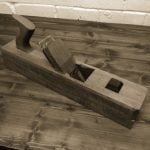converting a ripcut saw to a crosscut
Welcome! / Forums / General Woodworking Discussions / Tools and Tool Maintenance/Restoration / converting a ripcut saw to a crosscut
- This topic has 2 replies, 3 voices, and was last updated 4 years, 3 months ago by
 Ecky H.
Ecky H.
-
AuthorPosts
-
 10 January 2020 at 4:51 pm #644122
10 January 2020 at 4:51 pm #644122I have a spare 6tpi rip cut saw that I would like to convert to a crosscut pattern. Has anyone done this *without filing the teeth off and starting over?* . It is just as simple as adding some fleam to the teeth and file them equal passes until it is where I want it? Or do you have to file the teeth off to make it work?
 10 January 2020 at 6:35 pm #644136
10 January 2020 at 6:35 pm #644136You don’t need to file off the teeth. Just take your file and sharpen the teeth to a cross cut pattern.
It will take more strokes per tooth in order to establish the fleam, compared to sharpening an allready shaped crosscut tooth, but it’s easily done.
One think you may have to pay attention is the tooth rake. On rip cut saws the front side of the tooth tent to be at 90 degree angle to the tooth line, which makes the cut aggressive. On a cross cut saw you may keep the same aggressive rake or you may want to make it less aggressive by changing the rake angle (keeping the top face of the file parallel to the ground i.e.). Personally I tried both and I liked more the less aggressive cut on my crosscut saws.
You may also watch a youtube video by Paul Sellers (Hand Saw Comparisons is the title if I remember well) where he changes a saw from a cross cut to rip cut (you will have to go the other way around of course).

Hello Joe,
I did it in the opposite direction with a 13 tpi back saw, which came out quite well.
Converting a rip pattern to cross cut should be a bit easier.
Rip cut usually does have much more aggressive rake than cross cut. So my way would be to file only the tip of each tooth and only the front: adding fleam and reducing the rake.
But there’s always a “but”.
But please keep in mind that 6 tpi is fairly coarse and to work properly, at least 3 teeth must interact with the wood. That limits the capability of the saw for thin stock: theoretically at least 1/2″, practically more. My experience is that coarse pattern and thin stock lead to strong vibrations – tried it out with 7 tpi rip and 3/4″ stock.If you plan to make this saw especially for thick stock, it surely will be a “fast” saw…
E.
-
AuthorPosts
- You must be logged in to reply to this topic.
